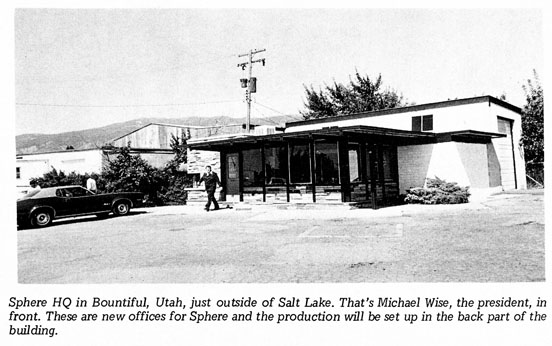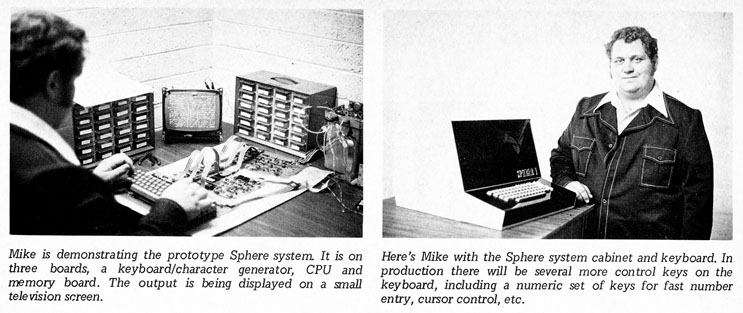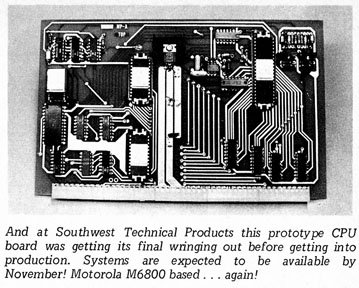My first stop was in Denver - a short layover between planes on my way to Salt Lake. I tried to locate the Digital Group there, but had no luck. Sorry about that. I know they are real because I recently sent them a check for their video display generator and received one a few days later in the mail. I was disappointed not to have a chance to talk with them at greater length.
In Salt Lake I was met by Doug Hancey of Sphere and driven out to their new plant in Bountiful, a suburb. It's a small building and I have a feeling that they will quickly be outgrowing the facilities ... I don't think they realize what a demand there is going to be for their system
They had a prototype up and running and it looked good. There were a couple of glitches, of course, but they seemed to have these well in hand and were expecting to be able to set up a production department very soon. The system is based upon the Motorola M6800 chip and features a PROM loader. They plan to have another PROM with Basic in it, which would be quite a step ahead for it would free all of the RAM memory for use and would permit instant use of Basic without the usual loading process.
I gather that Motorola has been extremely helpful in supplying information and support for the effort. This may have a lot to do with some of the other 6800 based computer systems which are coming out ... more on that later.
The plans were to setup a production facility in the back part of the building and have the first kits available in October. This will take some doing, but I wouldn't be surprised if they come close for they are a very determined group.
They have an interesting set of peripherals in the works, including some medium cost floppy disk systems, and a possible revolutionary tape system. We'll try to bring you up to date on Sphere as things progress.
MITS
The Altair 8800 has been selling well, as you probably know, and they are busy
keeping up with it. They are also in production on all sorts of interface and
control boards, memory boards, etc. They also have a very busy group of
college-types working away at program development. They are delivering Basic now
and are about ready to let loose Extended Basic. They put Basic into a system
for me so I could see it work ... then ran in a tape of a Hammurabi game program
and let me sit down and kill off the entire population of a mythical country in
short order ... and become instantly addicted to computer games. I promptly
ordered a complete Altair 8800 with enough memory to handle Star Trek. I wanted
it right now, but I had to get in line behind the other customers.
Next, in talking with Ed Roberts, the president of MITS, I found that the rumors of a new MITS system based upon the M6800 was much more than a rumor. The dates of release weren't firmed up yet, but it was definitely coming down the pike. Ed said that MITS would give good support to both the Intel 8080 and Motorola M6800 systems. With both Sphere and MITS producing 6800 systems Motorola was doing well and their solid backup of their chips was paying off. This would also mean a big plus to users since this would allow a lot more swapping of programs and would simplify interfacing of memory and peripherals.
We'll have a lot more info on just what MITS is doing and their plans in the near future.
From New Mexico I flew to San Antonio and a short visit to Southwest Technical Products, Dan Meyer proprietor. SWTP has long been well known for their excellent hi-fi kits. Readers of The Audio Amateur (Peterborough NH 03458) have been reading the SWTP ads for some time and seen the rave reviews of the equipment.
Dan has a good sized plant and is doing a substantial business in audio kits. I went there to just say hello and tell him how much I enjoyed putting his television typewriter kit together ... and to see what he might have up his sleeve for the future. To my amazement he had an M6800 CPU up and going, hooked to one of his TVT units. Those Motorola boys sure do get around. The plans are to have systems available in kit form by November . . . more support for 6800 systems ... more users, more programs.
This is an exciting time in the microprocessor business with systems getting going just about every month. The Sphere, MITS and SWTP systems are just the vanguard of what is coming. There are outfits talking about some slower systems ... probably 8008 based ... which will come in under $200 for the CPU ... and maybe even one for $100!
All of the firms are working hard to develop accessories, memories and programs. Look out 1976.
FLAKES
It just doesn't take any time at all for the flakes to rise. New as the computer
hobby field may be, there are already some sharp operators in there taking
advantage of the unwary. I'm put in mind of the "lifetime" guarantee offered by
a chap selling ball point pens in the subway cars in New York.
One flake is selling imitation Southwest Tech circuit boards (the television typewriter circuit). Good luck if you fall for this one. SW Tech is a substantial firm with a long history of good products and service to back them up - I've built their TV typewriter and it is splendid. Said flake is getting ready to put out imitation microprocessor boards ... and kits. Undoubtedly he will give all of the support to his boards and system that one might expect from someone operating out of a cellar.
Watch out!
WAYNE GREEN



